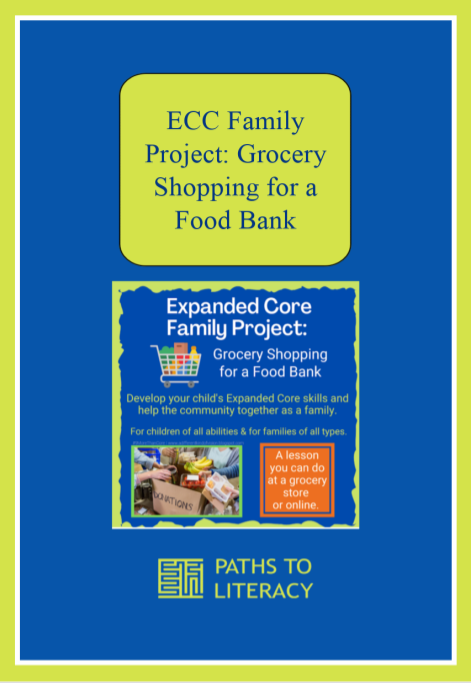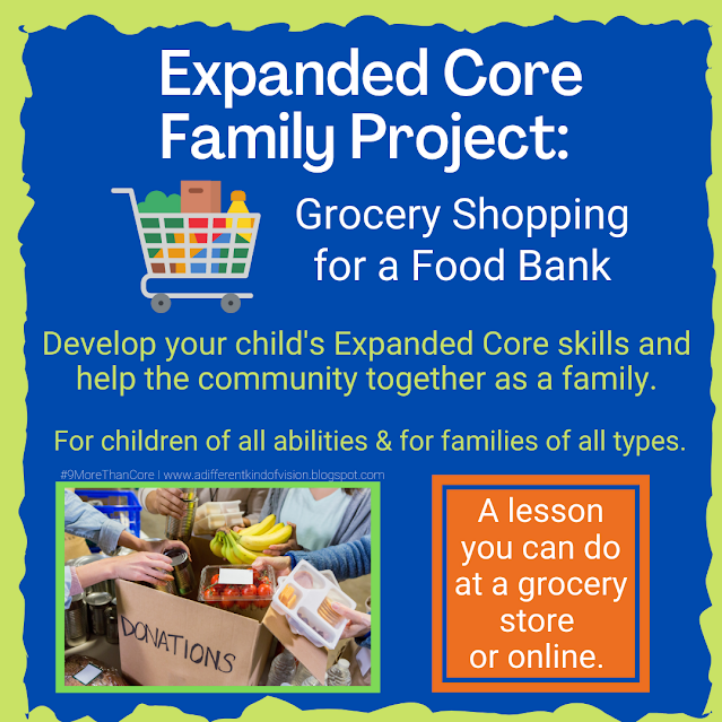ECC Family Project: Grocery Shopping for a Food Bank
Submitted by Robbin Keating Clark on Mar 12, 2022
Here's another great Expanded Core family project: grocery shopping for a food bank. ECC skills that could easily be infused into this idea and I knew that I had another family project for you. I have designed this idea for children of all abilities and families of all types. I'll be honest, this is another idea that comes straight from my own life. I read an article about our local food banks and there was a profile about the families who are receiving their support. I was quite struck by this as it reminded me that for most of my childhood I was a recipient of support. I decided to look up their needed items. I made a commitment that every time I go grocery shopping this year, I will pick items to support the local food bank.
Part One - Food Bank Research
As a family, look up your local food bank and learn about it. You can be as detailed as you need to meet your child where they are. Learn about what food banks are and what needs they have. I also encourage you to have your child call the food bank and conduct an interview. You will find out what specific needs your local bank has and it works conversation skills.
For moderate to typically developing students, have them use their tech skills and go online. Have them do the search on a device. I suggest a laptop so that everyone can read along with them (but you do what works for you!).
For symbolic level students, use real life simple pictures of a building. Use simplified language ("This is a food bank."). You can go to the site https://www.remove.bg/ and it will remove the background of a visually chaotic picture for free! Gather your information from your research. You can have your child be the speaker (they call the food bank), the researcher (they go online) or the secretary (they write the details and the shopping list). You can assign these responsibilities out to members of your family (this teaches career education).
Find the food bank address in your community. Have a quick discussion about the location of the food bank (after you researched the address). Consider these questions: is the food bank in a residential place? Is it in a strip mall? Go on a map and look at the street. Is it located on a busy street or main road or a side street? Does it have a stoplight controlled intersection. This quick discussion infuses orientation and mobility skills.

Part Two - Grocery Shopping Skills
You have two options for this part. You can go to the grocery store or you can order groceries online. For both options, start with a grocery list. You can have this in Braille, large print or pictures.
Option A: You can have a bit of fun with this part if you have the time. Start with your grocery list and play a type of the price is right with it. I do this a lot with students and it is super fun. Ask everyone to make a guess of how much items cost. This lets you know how much knowledge your child has about money skills. Then move onto grocery shopping.
Option B: Get right to grocery shopping. For in person grocery shopping, infuse AT skills by using an app such as Seeing AI or Be My Eyes. Divide your family into teams and work on the list together. Do not just put your child at the back of the cart and drag them around the store. Keep your child actively participating by giving them a specific task. For symbolic level students, give them pictures of what they are looking for. Let them put the item in the cart.
For online shopping, turn JAWS on so everyone knows what's going on. Your child may be inexperienced with online shopping so be partners in this effort. **If you feel overwhelmed, do this: think of one thing your child CAN do for this and one thing you STOP doing for this. It will give you some direction.
For both in person or online shopping, the payment section is a good place for your child to be actively engaged. You can use paper bills--more ideal for students who have multiple impairments or teach about using a card. I try to make sure that my students have both the card reader experience at a self-checkout and with a cashier. Go at a dead time so you don't feel rushed.
Last but never least, do the best you can! I've had so many grand ideas fail miserably when executed in real time. The focus is a family activity that helps the community. Pay attention to how your child does--are they way off with prices? Do they seem to not have strong internet skills? Do they not know much about grocery stores? Make some notes. Then call your teacher of students with vision impairments or OM instructor to work a plan to develop these skills. Pay attention to yourself--how much did you really help your child during these activities? Did you overpower during the lesson? All children can do something. Step back and let them do things before you jump in to help (easier said than done!).
Can you imagine if just twenty families did this activity? We would help our local communities so much!
Originally posted at A Different Kind of Vision by Robbin Keating Clark


